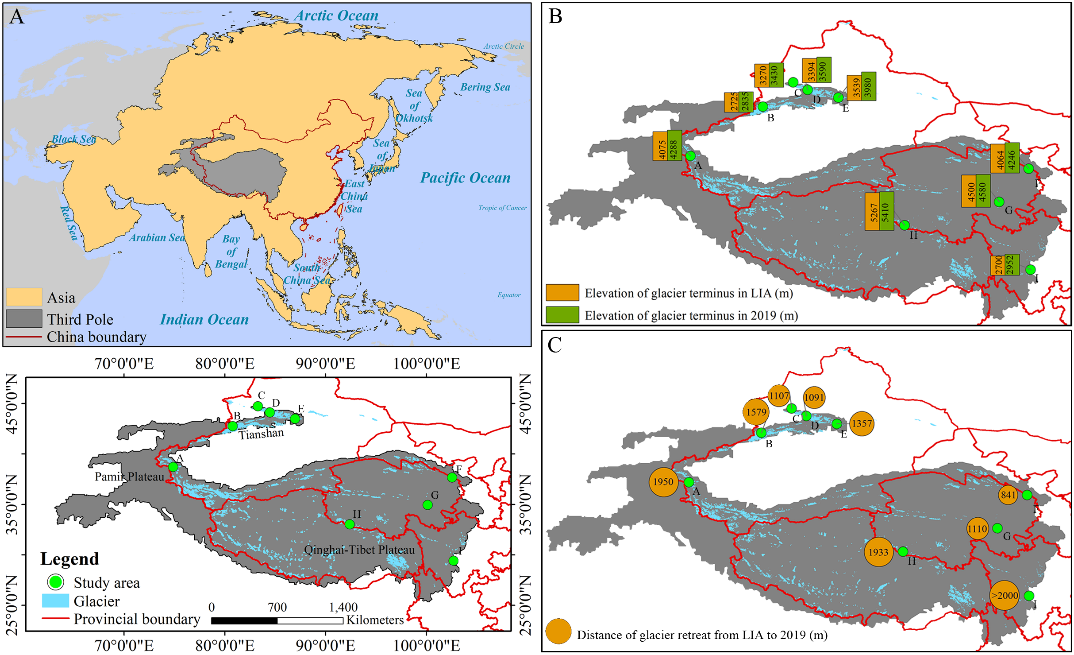
青藏高原及周边高山地区统称为“第三极”地区,是除南北极外最大的冰川集中区。在全球气候变暖背景下,第三极地区正经历显著增温,气温上升加速了冰川消融,进而影响区域生态平衡。第三极冰川前缘作为海拔最高的陆地脆弱生境之一,对气候及冰川变化响应敏感。深入了解冰川前缘植被动态,对科学评估冰缘生态系统响应气候至关重要。然而,受制于观测条件,目前仍缺乏对该地区冰缘植被的大范围系统性观测研究。 中国科学院西北生态环境资源研究院上官冬辉研究员团队与兰州交通大学、中巴地球科学联合研究中心及南通大学相关研究团队合作,选取第三极地区9条代表性冰川,在其前缘布设样地并获取植被信息。利用植被指数量化了冰川退缩时间序列上植物群落特征的变化,并结合植物区系相似性指数,系统分析了不同样地间及不同冰川前缘间的植物区系相似性。 研究显示,物种多样性和植被盖度沿冰川退缩时间序列呈波动增加趋势,且在海洋性冰川前缘的增加速率尤为显著。所有冰川前缘的植物生活型在演替早期阶段较为相似,但随着演替推进,生活型组成开始分化,在不同类型冰川前缘间差异更为明显。此外,不同冰川前缘间具有植物区系相似性,其中地理位置邻近且属于同一类型冰川的前缘地区植物区系相似性最高。 该研究揭示了局地气候与地理因子在塑造冰川前缘生态系统及植物区系格局中扮演的关键作用,为阐明气候变化对冰川前缘生态系统的影响提供了科学依据,并为区域生物多样性保护工作提供了理论指导。 该成果以Vegetation successional dynamics and floristic similarity across various glacier forelands in the third pole为题发表于国际知名学术期刊Global and Planetary Change上。兰州交通大学魏天锋副教授为本文第一作者,西北研究院上官冬辉研究员为本文通讯作者。研究得到中国科学院战略性先导科技专项(A类)和国家自然科学基金等项目的资助。 论文链接:https://doi.org/10.1016/j.gloplacha.2025.104916 (A)研究区地理区位图,(B)被研究冰川在小冰期和2019年的冰川末端海拔,(C)被研究冰川在小冰期至2019年间的冰川退缩距离
2025-06-09 中国科学院西北生态环境资源研究院Glacier forelands provide ideal natural laboratories for studying primary vegetation succession. However, understanding of vegetation dynamics on glacier forelands in the Third Pole (TP) region remains limited. In this study, we employed field sampling and aerial photography to investigate key vegetation parameters (species composition, species diversity, and fractional vegetation cover (FVC)) along chronosequences on nine representative glacier forelands of the TP, spanning continental, subcontinental, and maritime glacier types, then analyzed vegetation changes along successional gradients and assessed floristic similarity both within and among the glacier forelands. Our results showed that species diversity and FVC generally exhibited increasing trends, with fluctuations from young to old forelands. These parameters increased more rapidly on maritime glacier forelands. Plant life-forms were similar during the early stages across all forelands but began to diverge as succession progressed, particularly between different glacier types. Furthermore, floristic similarity was observed between glacier forelands, with the highest similarity occurring between forelands of the same glacier type in adjacent geographic locations. Our findings highlight the critical roles of local climate and geographic factors in shaping proglacial ecosystems and flora, providing a scientific basis for understanding the effects of climate change on proglacial ecosystems and guiding biodiversity conservation efforts.